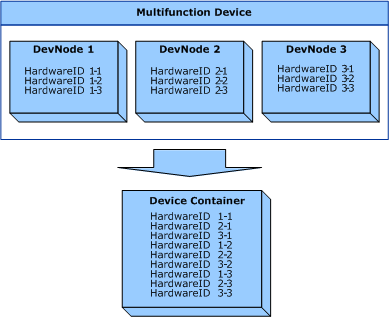Specifying Hardware IDs for a Multifunction Device
You can specify more than one HardwareID element for a physical device. This is done by specifying multiple HardwareID element values within the parent HardwareIDList element. Each value must specify a unique hardware ID for the device.
For example, consider a single-function USB printer from the company Contoso, Ltd. The following HardwareID elements can be used to define the device:
<HardwareIDList>
<HardwareID>DOID:USB\VID_1234&PID_1234&REV_0000</HardwareID>
<HardwareID>DOID:USB\VID_1234&PID_1234</HardwareID>
<HardwareID>DOID:USBPRINT\Contoso_Ltd_Co9999/HardwareID>
</HardwareIDList>
If the device is a multifunction device, a device container combines all the hardware IDs from the device nodes (devnodes) for each hardware function on the device. For more information about device containers and container IDs, see Container IDs.
The following figure shows the relationship between a multifunction device's devnodes and device container.

Depending on your multifunction device, you can decide which hardware ID values are specified by using separate HardwareID elements in the HardwareIDList element. Multiple hardware IDs can be specified in any order in the HardwareIDList element. However, you should be aware of the following points:
Within a given devnode, the ranking of hardware IDs by the operating system is deterministic. For example, in the previous figure, HardwareID1-1 is always ranked higher than HardwareID1-2 and HardwareID1-3.
The operating system does not consistently rank a hardware ID from one devnode higher than a hardware ID from another devnode. For example, in the previous figure, the operating system might not always rank HardwareID1-1 higher than HardwareID2-1.
Therefore, make sure that your metadata package does not rely on the order or ranking of hardware IDs across the devnodes for a device. You should use all relevant hardware IDs for your multifunction device in the HardwareIDList element of your device metadata package. This guarantees that the operating system selects your metadata package regardless of the ranking of hardware IDs.
Based on the devnode topology shown in the previous figure, consider the following suggestions:
Specify HardwareID1-1, HardwareID2-1, and Hardware ID3-1 in a new device metadata package if you have already published another metadata package that specifies only HardwareID2-1.
If the operating system ranks HardwareID2-1 higher than HardwareID1-1 and finds thatHardwareID2-1 is specified in both the old and new metadata package, the operating system selects the metadata package based on the value of the LastModifiedDate XML element. In this case, the operating system selects the new metadata package.
If your new metadata package lists only HardwareID1-1, the operating system will not select the new package if HardwareID2-1 is ranked higher than HardwareID1-1.
For more information about metadata package selection and ranking, see How the DMRC Selects a Device Metadata Package.
Feedback
Coming soon: Throughout 2024 we will be phasing out GitHub Issues as the feedback mechanism for content and replacing it with a new feedback system. For more information see: https://aka.ms/ContentUserFeedback.
Submit and view feedback for